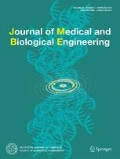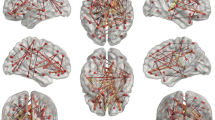Abstract
Brain structural analysis has been widely utilized to investigate brain network alterations caused by diseases. However, susceptibility distortions have been shown to influence tracking results and may detrimentally affect structural connectivity networks. Hence, the purposes of this study were (a) to reduce susceptibility distortions in brain structural networks by using diffusion tensor imaging with PROPELLER echo-planar imaging (pDTI), (b) to compare the differences in brain structural networks between this technique and conventional DTI with single-shot echo-planar imaging (ssDTI), and (c) to investigate sex differences in brain structural networks according to the two techniques. Forty healthy subjects (M/F = 20/20, age = 20–22 y/o) with no history of neurological disease participated in this study. For each participant, the two techniques were utilized to acquire imaging data from a 3.0 T MR scanner. Structural connectivity was statistically compared between these two techniques, as well as between male and female subjects. In connectivity analysis, the pDTI generally had significantly high connectivity between most cortical regions, whereas it exhibited significantly lower connectivity than ssDTI only in regions near the frontal, occipital, and brain stem areas. Furthermore, both techniques revealed consistent sex differences except in regions with susceptibility distortions. We concluded that pDTI might be a suitable alternative technique for investigating alterations in brain structural networks in regions with susceptibility distortions.





Similar content being viewed by others
References
Basser, P. J., Mattiello, J., & Lebihan, D. (1994). Mr diffusion tensor spectroscopy and imaging. Biophysical Journal, 66, 259–267.
Mori, S., Crain, B. J., Chacko, V. P., & van Zijl, P. C. M. (1999). Three-dimensional tracking of axonal projections in the brain by magnetic resonance imaging. Annals of Neurology, 45, 265–269.
Basser, P. J., Pajevic, S., Pierpaoli, C., Duda, J., & Aldroubi, A. (2000). In vivo fiber tractography using DT-MRI data. Magnetic Resonance in Medicine, 44, 625–632.
Ciccarelli, O., Catani, M., Johansen-Berg, H., Clark, C., & Thompson, A. (2008). Diffusion-based tractography in neurological disorders: concepts, applications, and future developments. Lancet Neurology, 7, 715–727.
Baur, V., Bruhl, A. B., Herwig, U., Eberle, T., Rufer, M., Delsignore, A., et al. (2013). Evidence of frontotemporal structural hypoconnectivity in social anxiety disorder: A quantitative fiber tractography study. Human Brain Mapping, 34, 437–446.
Torgerson, C. M., Irimia, A., Leow, A. D., Bartzokis, G., Moody, T. D., Jennings, R. G., et al. (2013). DTI tractography and white matter fiber tract characteristics in euthymic bipolar I patients and healthy control subjects. Brain Imaging and Behavior, 7, 129–139.
Ashtari, M., Cottone, J., Ardekani, B. A., Cervellione, K., Szeszko, P. R., Wu, J. H., et al. (2007). Disruption of white matter integrity in the inferior longitudinal fasciculus in adolescents with schizophrenia as revealed by fiber tractography. Archives of General Psychiatry, 64, 1270–1280.
Iturria-Medina, Y., Canales-Rodriguez, E. J., Melie-Garcia, L., Valdes-Hernandez, P. A., Martinez-Montes, E., Aleman-Gomez, Y., et al. (2007). Characterizing brain anatomical connections using diffusion weighted MRI and graph theory. Neuroimage, 36, 645–660.
Iturria-Medina, Y., Sotero, R. C., Canales-Rodriguez, E. J., Aleman-Gomez, Y., & Melie-Garcia, L. (2008). Studying the human brain anatomical network via diffusion-weighted MRI and graph theory. Neuroimage, 40, 1064–1076.
Hagmann, P., Cammoun, L., Gigandet, X., Meuli, R., Honey, C. J., Wedeen, V., et al. (2008). Mapping the structural core of human cerebral cortex. PLoS Biology, 6, 1479–1493.
Gong, G. L., He, Y., Concha, L., Lebel, C., Gross, D. W., Evans, A. C., et al. (2009). Mapping anatomical connectivity patterns of human cerebral cortex using in vivo diffusion tensor imaging tractography. Cerebral Cortex, 19, 524–536.
Rose, S., Pannek, K., Bell, C., Baumann, F., Hutchinson, N., Coulthard, A., et al. (2012). Direct evidence of intra- and interhemispheric corticomotor network degeneration in amyotrophic lateral sclerosis: An automated MRI structural connectivity study. Neuroimage, 59, 2661–2669.
Verstraete, E., Veldink, J. H., van den Berg, L. H., & van den Heuvel, M. P. (2014). Structural brain network imaging shows expanding disconnection of the motor system in amyotrophic lateral sclerosis. Human Brain Mapping, 35, 1351–1361.
Agosta, F., Galantucci, S., Riva, N., Chio, A., Messina, S., Iannaccone, S., et al. (2014). Intrahemispheric and interhemispheric structural network abnormalities in PLS and ALS. Human Brain Mapping, 35, 1710–1722.
Drevets, W. C., Price, J. L., & Furey, M. L. (2008). Brain structural and functional abnormalities in mood disorders: implications for neurocircuitry models of depression. Brain Structure & Function, 213, 93–118.
Bohlken, M. M., Brouwer, R. M., Mandl, R. C. W., Heuvel, M. P. V. D., Hedman, A. M., Hert, M. D., et al. (2016). Structural brain connectivity as a genetic marker for schizophrenia. JAMA Psychiatry, 73, 11–19.
Fornito, A., Zalesky, A., & Breakspear, M. (2015). The connectomics of brain disorders. Nature Reviews Neuroscience, 16, 159–172.
Rudie, J. D., Brown, J. A., Beck-Pancer, D., Hernandez, L. M., Dennis, E. L., Thompson, P. M., et al. (2013). Altered functional and structural brain network organization in autism. Neuroimage-Clinical, 2, 79–94.
Hagmann, P., Kurant, M., Gigandet, X., Thiran, P., Wedeen, V. J., Meuli, R., et al. (2007). Mapping human whole-brain structural networks with diffusion MRI. PLoS ONE, 2(7), e597.
Behrens, T. E. J., Berg, H. J., Jbabdi, S., Rushworth, M. F. S., & Woolrich, M. W. (2007). Probabilistic diffusion tractography with multiple fibre orientations: What can we gain? Neuroimage, 34, 144–155.
Buchanan, C. R., Pernet, C. R., Gorgolewski, K. J., Storkey, A. J., & Bastin, M. E. (2014). Test-retest reliability of structural brain networks from diffusion MRI. Neuroimage, 86, 231–243.
Irfanoglu, M. O., Walker, L., Sarlls, J., Marenco, S., & Pierpaoli, C. (2012). Effects of image distortions originating from susceptibility variations and concomitant fields on diffusion MRI tractography results. Neuroimage, 61, 275–288.
Embleton, K. V., Haroon, H. A., Morris, D. M., Ralph, M. A. L., & Parker, G. J. M. (2010). Distortion correction for diffusion-weighted MRI tractography and fMRI in the temporal lobes. Human Brain Mapping, 31, 1570–1587.
Bammer, R., Auer, M., Keeling, S. L., Augustin, M., Stables, L. A., Prokesch, R. W., et al. (2002). Diffusion tensor imaging using single-shot SENSE-EPI. Magnetic Resonance in Medicine, 48, 128–136.
Jaermann, T., Crelier, G., Pruessmann, K. P., Golay, X., Netsch, T., van Muiswinkel, A. M. C., et al. (2004). Sense-Dti at 3 T. Magnetic Resonance in Medicine, 51, 230–236.
Chou, M. C., Wang, C. Y., Liu, H. S., Chung, H. W., & Chen, C. Y. (2007). Pseudolesions arising from unfolding artifacts in diffusion imaging with use of parallel acquisition: Origin and remedies. American Journal of Neuroradiology, 28, 1099–1101.
Wang, F. N., Huang, T. Y., Lin, F. H., Chuang, T. C., Chen, N. K., Chung, H. W., et al. (2005). PROPELLER EPI: An MRI technique suitable for diffusion tensor Imaging at high field strength with reduced geometric distortions. Magnetic Resonance in Medicine, 54, 1232–1240.
Skare, S., Newbould, R. D., Clayton, D. B., & Bammer, R. (2006). Propeller EPI in the other direction. Magnetic Resonance in Medicine, 55, 1298–1307.
Chuang, T. C., Huang, T. Y., Lin, F. H., Wang, F. N., Juan, C. J., Chung, H. W., et al. (2006). PROPELLER-EPI with parallel imaging using a circularly symmetric phased-array RF coil at 3.0 T: Application to high-resolution diffusion tensor imaging. Magnetic Resonance in Medicine, 56, 1352–1358.
Skare, S., Newbould, R., Clayton, D., & Bammer, R. (2006). Diffusion Imaging using MinD SAP-EPI. In: Proceedings 14th Scientific Meeting International Society for Magnetic Resonance in Medicine, p. 857.
Chou, M. C., Huang, T. Y., Chung, H. W., Hsieh, T. J., Chang, H. C., & Chen, C. Y. (2013). Q-ball imaging with PROPELLER EPI acquisition. NMR in Biomedicine, 26, 1723–1732.
Forde, N. J., O’Donoghue, S., Scanlon, C., Emsell, L., Chaddock, C., Leemans, A., et al. (2015). Structural brain network analysis in families multiply affected with bipolar I disorder. Psychiatry Research-Neuroimaging, 234, 44–51.
Kim, H., Kim, J., Loggia, M. L., Cahalan, C., Garcia, R. G., Vangel, M. G., et al. (2015). Fibromyalgia is characterized by altered frontal and cerebellar structural covariance brain networks. NeuroImage: Clinical, 7, 667–677.
Lo, C. Y., Wang, P. N., Chou, K. H., Wang, J. H., He, Y., & Lin, C. P. (2010). Diffusion tensor tractography reveals abnormal topological organization in structural cortical networks in Alzheimer’s disease. Journal of Neuroscience, 30, 16876–16885.
Jones, D. K., Horsfield, M. A., & Simmons, A. (1999). Optimal strategies for measuring diffusion in anisotropic systems by magnetic resonance imaging. Magnetic Resonance in Medicine, 42, 515–525.
Skare, S., Hedehus, M., Moseley, M. E., & Li, T. Q. (2000). Condition number as a measure of noise performance of diffusion tensor data acquisition schemes with MRI. Journal of Magnetic Resonance, 147, 340–352.
Holland, D., Kuperman, J. M., & Dale, A. M. (2010). Efficient correction of inhomogeneous static magnetic field-induced distortion in Echo Planar Imaging. Neuroimage, 50, 175–183.
Zhan, L., Franc, D., Patel, V., Jahanshad, N., Jin, Y., Mueller, B. A., et al. (2016). How do spatial and angular resolution affect brain connectivity maps from diffusion MRI?. In: Proceedings IEEE International Symposium on Biomedical Imaging, pp. 1–6.
Andersson, J. L., Richter, M. C., Richter, W., Skare, S., Nunes, R. G., Robson, M. D., et al. (2004). Effects of susceptibility distortions on tractography. In: Proceedings 12th Scientific Meeting International Society for Magnetic Resonance in Medicine, p. 87.
Esteban, O., Daducci, A., Caruyer, E., O’Brien, K., Ledesma-Carbayo, M. J., Bach-Cuadra, M., et al. (2014). Simulation-based evaluation of susceptibility distortion correction methods in diffusion MRI for connectivity analysis. In: Proceedings IEEE International Symposium on Biomedical Imaging, pp. 738–741.
Ingalhalikar, M., Smith, A., Parker, D., Satterthwaite, T. D., Elliott, M. A., Ruparel, K., et al. (2014). Sex differences in the structural connectome of the human brain. Proceedings of the National academy of Sciences of the United States of America, 111, 823–828.
Sun, Y., Lee, R., Chen, Y., Collinson, S., Thakor, N., Bezerianos, A., et al. (2015). Progressive gender differences of structural brain networks in healthy adults: A longitudinal. Diffusion Tensor Imaging Study. Plos One, 10(3), e0118857.
Author information
Authors and Affiliations
Corresponding author
Rights and permissions
About this article
Cite this article
Lin, YL., Hsieh, TJ. & Chou, MC. Construction of Brain Structural Connectome Using PROPELLER Echo-Planar Diffusion Tensor Imaging with Probabilistic Tractography: Comparison with Conventional Imaging. J. Med. Biol. Eng. 38, 625–633 (2018). https://doi.org/10.1007/s40846-017-0335-0
Received:
Accepted:
Published:
Issue Date:
DOI: https://doi.org/10.1007/s40846-017-0335-0




